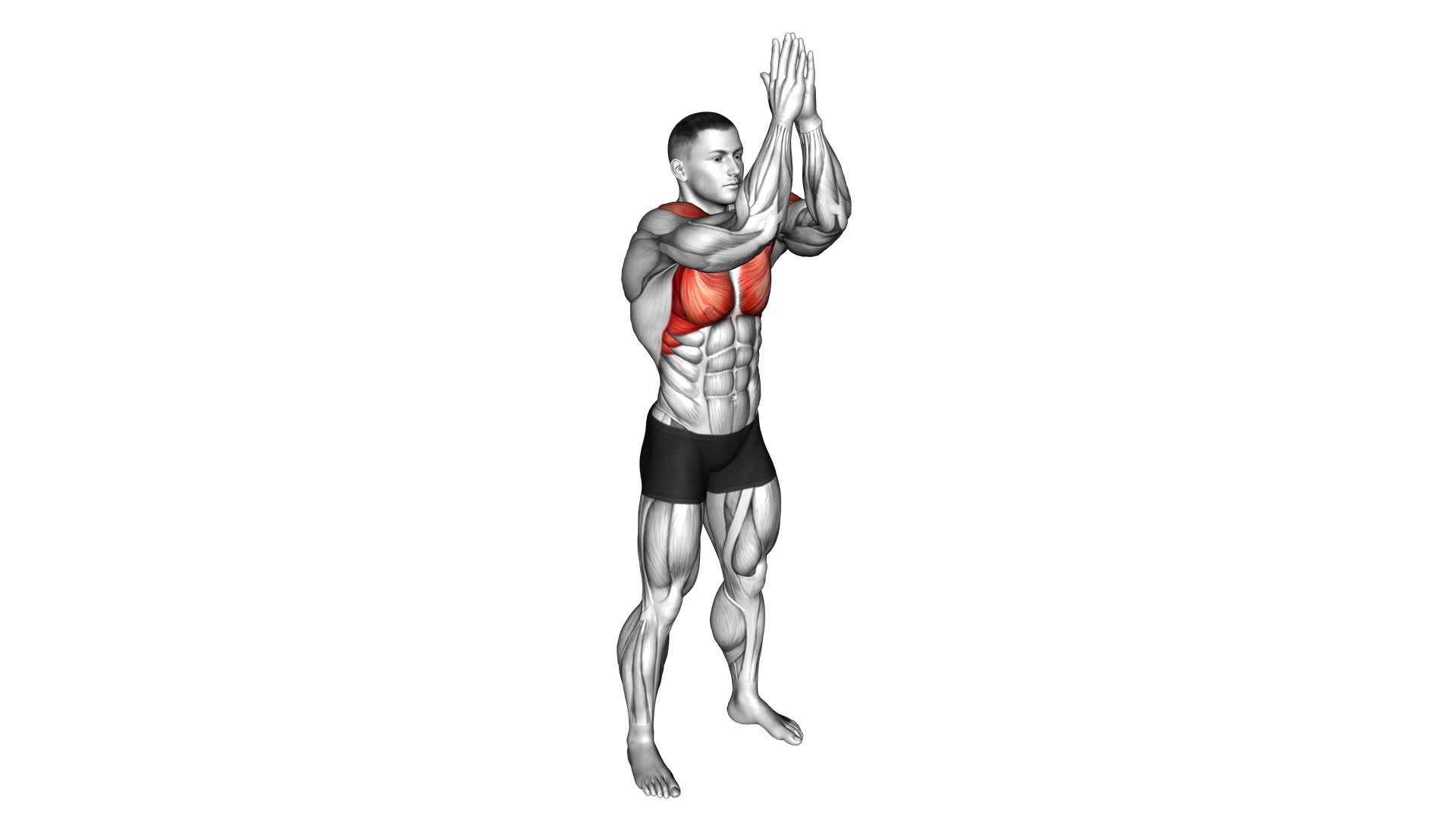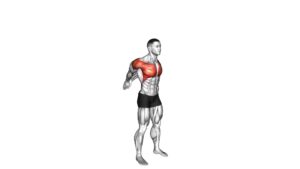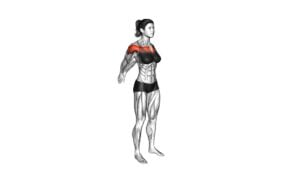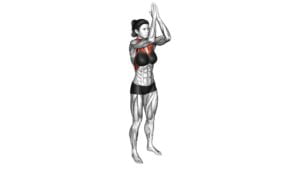Standing Elbow Clap (male) – Video Exercise Guide & Tips

Are you looking to add a challenging exercise to your routine? Check out the Standing Elbow Clap!
Watch This Exercise Video
This video exercise guide will show you proper form and technique, as well as common mistakes to avoid. Plus, we'll share tips to increase the difficulty and intensity.
Whether you're a beginner or a seasoned fitness enthusiast, there are variations and modifications for every fitness level.
Get ready to take your workout to the next level with the Standing Elbow Clap.
Key Takeaways
- The standing elbow clap is a beneficial exercise for improving upper body strength, coordination, agility, and targeting the chest, shoulders, and arms.
- It is important to maintain proper form and technique, including standing with feet shoulder-width apart, keeping the core engaged and back straight, and avoiding rounding shoulders, dropping elbows, and using excessive momentum.
- Common mistakes to avoid while performing the exercise include rounding shoulders, using excessive force, leaning forward or backward, compromising form, and straining or injuring shoulders, elbows, or wrists.
- To increase the difficulty and intensity of the exercise, one can slow down the tempo, increase the range of motion, add resistance with dumbbells or resistance bands, combine with other upper body exercises, and incorporate into a circuit or superset.
Benefits of the Standing Elbow Clap
You will experience improved upper body strength and coordination through the Standing Elbow Clap exercise. This exercise specifically targets your upper body muscles, including your chest, shoulders, and arms. By repeatedly clapping your hands behind your back, you're engaging and strengthening these muscles. The movement also requires coordination and agility as you need to synchronize the motion of your hands and arms.
The Standing Elbow Clap exercise is an effective way to increase your upper body strength. As you consistently perform this exercise, you'll notice an improvement in the strength of your chest, shoulders, and arms. This increased strength won't only benefit you in everyday activities but also in sports and other physical activities that require upper body strength.
In addition to increased strength, the Standing Elbow Clap exercise also improves coordination and agility. The movement of clapping your hands behind your back requires precise coordination between your hands and arms. As you practice this exercise, your coordination and agility will improve, making you more efficient in your movements. This can have a positive impact on various physical activities, such as sports, dancing, and even everyday tasks that require coordination.
Proper Form and Technique for the Exercise
To execute the Standing Elbow Clap exercise correctly, maintain a strong posture and engage your upper body muscles. Here are some important tips to ensure proper form and technique:
- Stand with your feet shoulder-width apart and your knees slightly bent. This will provide a stable base for the exercise.
- Keep your core engaged and your back straight throughout the movement. This will help to prevent any strain on your lower back.
- Start by raising both arms out to the sides at shoulder height, with your elbows bent at a 90-degree angle.
- As you exhale, quickly bring your elbows together in front of your chest, clapping your forearms together. Make sure to keep your wrists straight and your elbows at shoulder height.
Common mistakes to watch out for include rounding your shoulders, allowing your elbows to drop too low, or using excessive momentum to perform the movement. Remember to focus on controlled and deliberate movements to maximize the effectiveness of the exercise.
Variations and modifications can be made by adjusting the speed and intensity of the clap or by using different hand positions, such as overlapping your hands instead of clapping your forearms together. Experiment with these variations to challenge yourself and target different muscles in your upper body.
Common Mistakes to Avoid While Performing the Standing Elbow Clap
One common mistake to avoid when performing the Standing Elbow Clap exercise is rounding your shoulders, which can compromise proper form and reduce the effectiveness of the movement. It's important to maintain a straight and upright posture throughout the exercise to engage the targeted muscles correctly.
Another common mistake is using excessive force when clapping your elbows together. This can lead to strain or injury in the shoulders, elbows, or wrists. Instead, focus on controlled and precise movements, ensuring that you don't compromise your form.
Additionally, avoid leaning forward or backward during the exercise, as this can put unnecessary stress on the spine and decrease the effectiveness of the exercise. To prevent these mistakes, it's crucial to pay attention to your body positioning and maintain proper technique throughout the movement.
By avoiding these common mistakes, you'll be able to perform the Standing Elbow Clap exercise safely and effectively.
Now, let's move on to the next section and discuss some tips to increase the difficulty and intensity of the exercise.
Tips to Increase the Difficulty and Intensity of the Exercise
To increase the difficulty and intensity of the Standing Elbow Clap exercise, consider incorporating variations in tempo and range of motion. Here are some tips to help you increase the challenge and incorporate advanced techniques:
- Slow down the tempo: Performing the exercise at a slower pace will engage your muscles for a longer duration, increasing the intensity and promoting muscle growth.
- Increase the range of motion: Instead of just clapping your elbows together, try reaching your hands higher above your head or extending your arms farther out to the sides. This will activate more muscles and challenge your upper body strength.
- Add resistance: Hold a lightweight dumbbell or resistance band in each hand while performing the exercise. This will provide additional resistance, making the movement more challenging and effective.
- Combine with other exercises: Incorporate the Standing Elbow Clap into a circuit or superset with other upper body exercises. This will keep your heart rate up and maximize the overall intensity of your workout.
Variations and Modifications for Different Fitness Levels
Increase the challenge and cater to different fitness levels with variations and modifications of the Standing Elbow Clap exercise. Whether you're a beginner or an advanced fitness enthusiast, there are different ways to adapt this exercise to your specific needs.
To increase the difficulty of the Standing Elbow Clap, you can incorporate different equipment such as dumbbells or resistance bands. Holding a dumbbell in each hand while performing the exercise will add resistance and engage your muscles even more. Similarly, using a resistance band will provide continuous tension throughout the movement, making it more challenging.
If you're a beginner or have limited upper body strength, there are alternative exercises that can help you build up to the Standing Elbow Clap. One option is to perform the exercise against a wall instead of doing it in a standing position. This modification will reduce the amount of weight you have to support and allow you to focus on mastering the movement pattern.
Another modification for beginners is to perform the exercise from a kneeling position. This will decrease the amount of bodyweight you have to lift and make it easier to execute the movement correctly.
Frequently Asked Questions
How Many Calories Can Be Burned by Performing the Standing Elbow Clap Exercise?
By performing the standing elbow clap exercise, you can burn a significant amount of calories. This exercise engages multiple muscle groups, such as the shoulders, chest, and triceps, leading to an increased calorie burn.
The exact number of calories burned will depend on factors such as your weight, intensity, and duration of the exercise.
It's always important to listen to your body and make injury modifications if necessary.
Can the Standing Elbow Clap Exercise Help Improve Upper Body Strength?
The standing elbow clap exercise can definitely help improve your upper body strength. By repeatedly clapping your hands behind your back, you engage your chest, shoulders, and triceps muscles.
This exercise also promotes flexibility in your shoulders and upper back. To further challenge yourself, you can try variations of the standing elbow clap exercise, such as clapping higher or faster.
Incorporating this exercise into your workout routine will contribute to a stronger upper body.
Is the Standing Elbow Clap Exercise Suitable for Individuals With Shoulder Injuries?
The standing elbow clap exercise can be modified for individuals with shoulder injuries to accommodate shoulder rehabilitation. By making adjustments such as reducing the range of motion or using lighter weights, you can still engage the upper body muscles without putting excessive strain on the injured shoulder.
It's important to consult with a healthcare professional or a certified trainer to ensure you're performing the exercise correctly and safely.
Can the Standing Elbow Clap Exercise Help Improve Coordination and Balance?
The standing elbow clap exercise can definitely help improve coordination and balance. By incorporating this exercise into your routine, you can work on enhancing your motor skills and agility.
It requires you to engage multiple muscle groups and focus on timing and precision. This exercise is a great way to challenge yourself and improve your overall physical abilities.
Remember to always consult with a professional if you have any concerns or injuries.
How Often Should the Standing Elbow Clap Exercise Be Performed for Optimal Results?
To achieve optimal results from the standing elbow clap exercise, it's important to consider the frequency and timing. The frequency of performing the exercise depends on your fitness level and goals. Generally, it's recommended to do the standing elbow clap exercise 2-3 times per week.
As for the best time to perform the exercise, it can be incorporated into your regular workout routine or done as a standalone exercise. Consistency and proper form are key to seeing improvements in coordination and balance.
Conclusion
In conclusion, the standing elbow clap is a beneficial exercise that targets the upper body muscles and improves coordination. By following proper form and technique, you can avoid common mistakes and maximize the effectiveness of the exercise.
To make it more challenging, try increasing the speed or adding resistance. Additionally, there are variations and modifications available for different fitness levels.
Incorporating the standing elbow clap into your workout routine can help enhance strength and overall fitness.

Author
Years ago, the spark of my life’s passion ignited in my mind the moment I stepped into the local gym for the first time. The inaugural bead of perspiration, the initial endeavor, the very first surge of endorphins, and a sense of pride that washed over me post-workout marked the beginning of my deep-seated interest in strength sports, fitness, and sports nutrition. This very curiosity blossomed rapidly into a profound fascination, propelling me to earn a Master’s degree in Physical Education from the Academy of Physical Education in Krakow, followed by a Sports Manager diploma from the Jagiellonian University. My journey of growth led me to gain more specialized qualifications, such as being a certified personal trainer with a focus on sports dietetics, a lifeguard, and an instructor for wellness and corrective gymnastics. Theoretical knowledge paired seamlessly with practical experience, reinforcing my belief that the transformation of individuals under my guidance was also a reflection of my personal growth. This belief holds true even today. Each day, I strive to push the boundaries and explore new realms. These realms gently elevate me to greater heights. The unique combination of passion for my field and the continuous quest for growth fuels my drive to break new ground.







